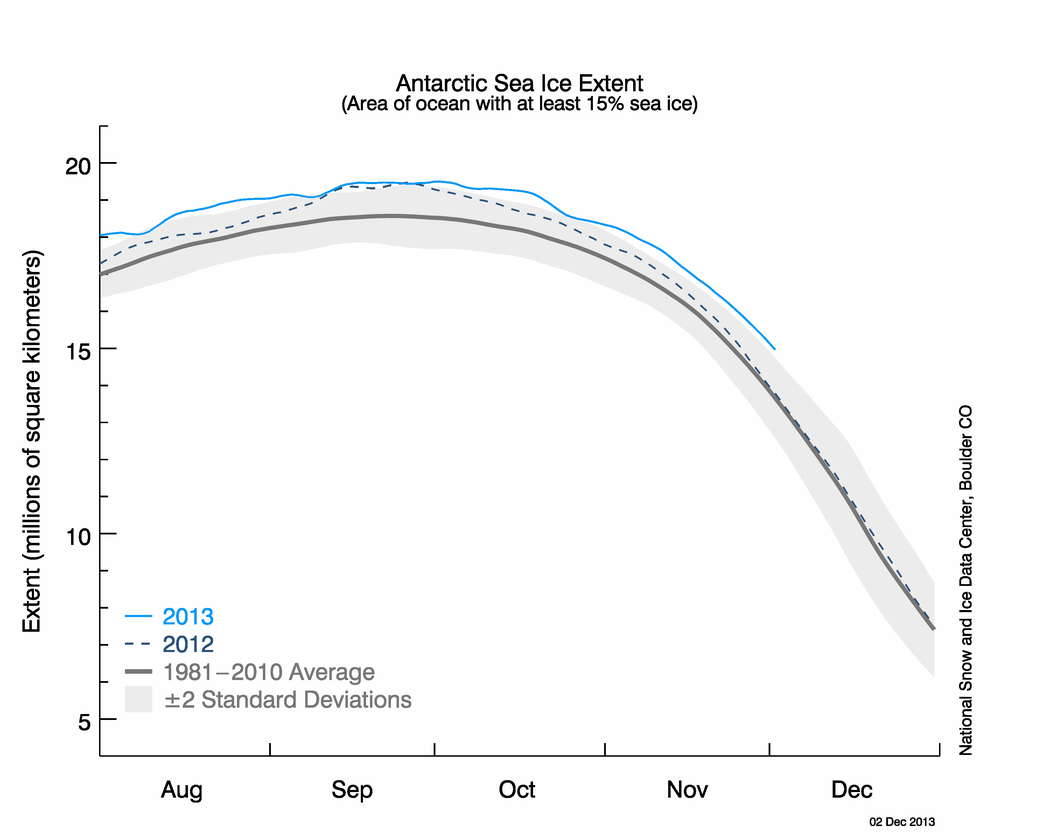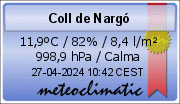" METEOROLOGÍA:PERFLUOROTRIBUTILAMINA "
Hola a todos.
En una pequeña reseña que publica en la página de meteorología "La Vanguardia" de Barcelona se publica lo siguiente "una reciente investigación ha descubierto que la susbtancia química, perfluorotributilamina provoca 7.100 veces más efecto invernadero que el dióxido de carbono". La sección estaba firmada por Joaquim Serra.
Me he lanzado a buscar de que producto se trataba y si podía entresacar algún dato más. Como resumen concluyo que se trata de un material de uso reciente ( a mediados del siglo XX ) y que se utilización "está vinculada a los líquidos que se comercializan para facilitar la transferencia de calor en diversos aparatos, es decir, en líquidos especiales que como es lógico, deben ser térmica y químicamente muy estables".Queda claro que "sólo el hombre lo puede generar". Además sus concentaciones son bajísimas comparadas con el CO2, pero sus repercusiones en el medio son infinitamente superiores, con un período de residencia de unos 500 años.
O sea nuevo tema para preocuparse, y seguimos descubriendo elementos nocivos de los que nadie habó hasta hace un par de semanas. Perfecto, vamos por buen camino.
Detectan nuevo gas de efecto invernadero
potentísimo
Publicado el Dic 19, 2013
 Jason Lyon/iStock/Thinkstock
Jason Lyon/iStock/Thinkstock Hace pocos días se ha dado a conocer la existencia de un nuevo gas de efecto invernadero con una actividad exponencialmente mayor que los que se conocen en la actualidad, su nombre: perfluorotributilamina. Te invitamos a conocer más sobre el mismo.
¿Qué es la perfluorotributilamina?
La perfluorotributilamina (PFTBA) es una sustancia que se produce desde mediados del siglo XX y que es empleada en procesos industriales relacionados con la fabricación de equipos eléctricos. Está vinculada a los líquidos que se comercializan para facilitar la transferencia de calor en diversos aparatos, es decir, en líquidos especiales que como es lógico, deben ser térmica y químicamente muy estables.Está particularmente asociado a la industria de los transistores y los capacitadores, siendo un compuesto totalmente sintético, o sea, que no se produce nunca de forma natural, sólo el hombre lo puede generar.
Un potente gas de efecto invernadero
Hasta el momento, el CO2 ha sido considerado el culpable por excelencia del efecto invernadero, dado sobre todo por las inmensas cantidades de este gas que hay en la atmósfera, producto de la quema de combustibles fósiles por parte del ser humano y procesos naturales como las erupciones volcánicas y muchas otros.Pues según han dado a conocer recientemente unos científicos de la Universidad de Toronto, en Canadá, el gas de perfluorotributilamina es la molécula con el efecto más potente sobre la atmósfera que existe hasta donde sabemos. Según el artículo que han publicado en la revista Geophysical Research Letters, el PFTBA es hasta 7000 veces más dañino para la atmósfera que el dióxido de carbono, y es capaz de permanecer por 500 años en suspensión antes de disolverse, ya que la naturaleza no tiene forma de reciclarlo, como ocurre con el CO2.
Por suerte, según plantean, las concentraciones atmosféricas de la perfluorotributilamina son bastante bajas en comparación con las del dióxido de carbono, ya que están en el orden de 0,18 partes por trillón frente a las 400 partes por trillón. No obstante estas cifras no pueden ser subestimadas de ninguna manera debido a la perdurabilidad y potente actividad de cada molécula de PFTBA, en la que cada molécula tiene el impacto equivalente a 7100 moléculas de CO2.
Este descubrimiento es sumamente importante ya que se espera que contribuya a tomar medidas para reducir la emisión de este dañino gas industrial.
Newly discovered greenhouse gas '7,000 times more powerful than CO2'
Perfluorotributylamine is an unregulated, long-living industrial chemical that breaks all records for potential climate impacts.

Haze over the CN Tower and downtown Toronto. Researchers have discovered a new greenhouse gas called perfluorotributylamine. Photograph: Andrew Francis Wallace/Getty Images
A new greenhouse gas that is 7,000 times more powerful than carbon dioxide at warming the Earth has been discovered by researchers in Toronto.
The newly discovered gas, perfluorotributylamine (PFTBA), has been in use by the electrical industry since the mid-20th century.
The chemical, that does not occur naturally, breaks all records for potential impacts on the climate, said the researchers at the University of Toronto's department of chemistry.
"We claim that PFTBA has the highest radiative efficiency of any molecule detected in the atmosphere to date," said Angela Hong, one of the co-authors.
The study, published in the journal Geophysical Research Letters, found PFTBA was 7,100 times more powerful at warming the Earth over a 100-year time span than CO2.
Concentrations of PFTBA in the atmosphere are low – 0.18 parts per trillion in the Toronto area – compared to 400 parts per million for carbon dioxide. So PFTBA does not in any way displace the burning of fossil fuels such as oil and coal as the main drivers of climate change.
Dr Drew Shindell, a climatologist at Nasa's Goddard Institute for Space Studies, said:
"This is a warning to us that this gas could have a very very large impact on climate change – if there were a lot of it. Since there is not a lot of it now, we don't have to worry about it at present, but we have to make sure it doesn't grow and become a very large contributor to global warming.".
He said a number of recent studies had drawn attention to other potential new greenhouse gases which, like PFTBA, pack a lot of warming potential in each molecule but are not very prevalent in the atmosphere.
Such studies were a warning against increasing uses of such compounds without first understanding their impact on climate change, he added.
"From a climate change perspective, individually, PFTBA's atmospheric concentration does not significantly alert the phenomenon of climate change," Hong said. "Still the biggest culprit is CO2 from fossil fuel emissions."
But PFTBA is long-lived. The Toronot researchers estimated PFTBA remains in the atmosphere for about 500 years, and unlike carbon dioxide, that is taken up by forests and oceans, there are no known natural "sinks" on Earth to absorb it.
"It is so much less than carbon dioxide, but the important thing is on a per molecule basis, it is very very effective in interacting with heat from the Earth," she said. "Individually each molecule is able to affect the climate potentially and because its lifetime is so long it also has a long-lasting effect."
Hong said the discovery of PFTBA and its warming potential raises questions about the climate impacts of other chemicals used in industrial processes.
PFTBA has been in use since the mid-20th century for various applications in electrical equipment, such as transistors and capacitors. The researchers said it was unclear how widespread its use was today.
It belongs to an entire class of chemicals used for industrial applications whose effects on the atmosphere remain unknown.
"PFTBA is just one example of an industrial chemical that is produced but there are no policies that control its production, use or emission," Hong said. "It is not being regulated by any type of climate policy."
The newly discovered gas, perfluorotributylamine (PFTBA), has been in use by the electrical industry since the mid-20th century.
The chemical, that does not occur naturally, breaks all records for potential impacts on the climate, said the researchers at the University of Toronto's department of chemistry.
"We claim that PFTBA has the highest radiative efficiency of any molecule detected in the atmosphere to date," said Angela Hong, one of the co-authors.
The study, published in the journal Geophysical Research Letters, found PFTBA was 7,100 times more powerful at warming the Earth over a 100-year time span than CO2.
Concentrations of PFTBA in the atmosphere are low – 0.18 parts per trillion in the Toronto area – compared to 400 parts per million for carbon dioxide. So PFTBA does not in any way displace the burning of fossil fuels such as oil and coal as the main drivers of climate change.
Dr Drew Shindell, a climatologist at Nasa's Goddard Institute for Space Studies, said:
"This is a warning to us that this gas could have a very very large impact on climate change – if there were a lot of it. Since there is not a lot of it now, we don't have to worry about it at present, but we have to make sure it doesn't grow and become a very large contributor to global warming.".
He said a number of recent studies had drawn attention to other potential new greenhouse gases which, like PFTBA, pack a lot of warming potential in each molecule but are not very prevalent in the atmosphere.
Such studies were a warning against increasing uses of such compounds without first understanding their impact on climate change, he added.
"From a climate change perspective, individually, PFTBA's atmospheric concentration does not significantly alert the phenomenon of climate change," Hong said. "Still the biggest culprit is CO2 from fossil fuel emissions."
But PFTBA is long-lived. The Toronot researchers estimated PFTBA remains in the atmosphere for about 500 years, and unlike carbon dioxide, that is taken up by forests and oceans, there are no known natural "sinks" on Earth to absorb it.
"It is so much less than carbon dioxide, but the important thing is on a per molecule basis, it is very very effective in interacting with heat from the Earth," she said. "Individually each molecule is able to affect the climate potentially and because its lifetime is so long it also has a long-lasting effect."
Hong said the discovery of PFTBA and its warming potential raises questions about the climate impacts of other chemicals used in industrial processes.
PFTBA has been in use since the mid-20th century for various applications in electrical equipment, such as transistors and capacitors. The researchers said it was unclear how widespread its use was today.
It belongs to an entire class of chemicals used for industrial applications whose effects on the atmosphere remain unknown.
"PFTBA is just one example of an industrial chemical that is produced but there are no policies that control its production, use or emission," Hong said. "It is not being regulated by any type of climate policy."

The small town of Reese, Michigan, is a cluster of white and green around the crossroads of two railroads and a highway in this true-color image. Acquired by the Advanced Land Imager (ALI) on NASA’s Earth Observing-1 (EO-1) satellite, the image shows the town on May 21, 2012.
Nasa Earth Observatory. En ningún rincón de España he visto desde del aire un reparto de cultivos tan perfectamente geométrico.
De momento nada más, saludos.
Mariscal Tro




















































